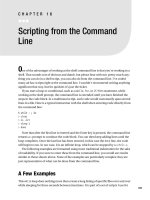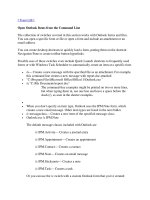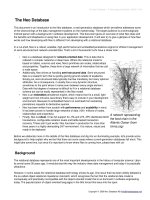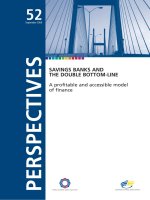The linux command line - a complete introduction
Bạn đang xem bản rút gọn của tài liệu. Xem và tải ngay bản đầy đủ của tài liệu tại đây (5.93 MB, 482 trang )
You’ve experienced the shiny, point-and-click surface
of your Linux computer—now dive below and explore
its depths with the power of the command line.
The Linux Command Line takes you from your very first
terminal keystrokes to writing full programs in Bash, the
most popular Linux shell. Along the way you’ll learn
the timeless skills handed down by generations of
gray-bearded, mouse-shunning gurus: file navigation,
environment configuration, command chaining, pattern
matching with regular expressions, and more.
In addition to that practical knowledge, author William
Shotts reveals the philosophy behind these tools and
the rich heritage that your desktop Linux machine has
inherited from Unix supercomputers of yore.
As you make your way through the book’s short, easily
digestible chapters, you’ll learn how to:
• Create and delete files, directories, and symlinks
• Administer your system, including networking,
package installation, and process management
BANISH YOUR
MOUSE
BANISH YOUR
MOUSE
• Use standard input and output, redirection, and
pipelines
• Edit files with Vi, the world’s most popular text editor
• Write shell scripts to automate common or boring tasks
• Slice and dice text files with cut, paste, grep, patch,
and sed
Once you overcome your initial “shell shock,” you’ll
find that the command line is a natural and expressive
way to communicate with your computer. Just don’t be
surprised if your mouse starts to gather dust.
ABOUT THE AUTHOR
William E. Shotts, Jr., has been a software professional
and avid Linux user for more than 15 years. He has an
extensive background in software development, including
technical support, quality assurance, and documentation.
He is also the creator of LinuxCommand.org, a Linux
education and advocacy site featuring news, reviews,
and extensive support for using the Linux command line.
SHELVE IN:
COMPUTERS/LINUX
$49.95 ($52.95 CDN)
www.nostarch.com
THE FINEST IN GEEK ENTERTAINMENT
™
FSC LOGO
“I LIE FLAT.”
This book uses RepKover— a durable binding that won’t snap shut.
A COMPLETE INTRODUCTION
THE LINUX
COMMAND LINE
THE LINUX
COMMAND LINE
WILLIAM E. SHOTTS, JR.
THE LINUX COMMAND LINE
THE LINUX COMMAND LINE
SHOTTS
THE LINUX COMMAND LINE
THE LINUX
COMMAND LINE
A Complete
Introduction
by William E. Shotts, Jr.
San Francisco
THE LINUX COMMAND LINE. Copyright © 2012 by William E. Shotts, Jr.
All rights reserved. No part of this work may be reproduced or transmitted in any form or by any means, electronic
or mechanical, including photocopying, recording, or by any information storage or retrieval system, without the
prior written permission of the copyright owner and the publisher.
16 15 14 13 12 1 2 3 4 5 6 7 8 9
ISBN-10: 1-59327-389-4
ISBN-13: 978-1-59327-389-7
Publisher: William Pollock
Production Editor: Serena Yang
Cover Design: Octopod Studios
Developmental Editor: Keith Fancher
Technical Reviewer: Therese Bao
Copyeditor: Ward Webber
Compositors: Serena Yang and Alison Law
Proofreader: Paula L. Fleming
For information on book distributors or translations, please contact No Starch Press, Inc. directly:
No Starch Press, Inc.
38 Ringold Street, San Francisco, CA 94103
phone: 415.863.9900; fax: 415.863.9950; ; www.nostarch.com
Library of Congress Cataloging-in-Publication Data
Shotts, William E.
The Linux command line: a complete introduction / William E. Shotts, Jr.
p. cm.
Includes index.
ISBN-13: 978-1-59327-389-7 (pbk.)
ISBN-10: 1-59327-389-4 (pbk.)
1. Linux. 2. Scripting Languages (Computer science) 3. Operating systems (Computers) I. Title.
QA76.76.O63S5556 2011
005.4'32 dc23
2011029198
No Starch Press and the No Starch Press logo are registered trademarks of No Starch Press, Inc. Other product and
company names mentioned herein may be the trademarks of their respective owners. Rather than use a trademark
symbol with every occurrence of a trademarked name, we are using the names only in an editorial fashion and to
the benefit of the trademark owner, with no intention of infringement of the trademark.
The information in this book is distributed on an “As Is” basis, without warranty. While every precaution has been
taken in the preparation of this work, neither the author nor No Starch Press, Inc. shall have any liability to any
person or entity with respect to any loss or damage caused or alleged to be caused directly or indirectly by the
information contained in it.
To Karen
BRIEF CONTENTS
Acknowledgments xxiii
Introduction xxv
PART 1: LEARNING THE SHELL
Chapter 1: What Is the Shell? 3
Chapter 2: Navigation 7
Chapter 3: Exploring the System 13
Chapter 4: Manipulating Files and Directories 25
Chapter 5: Working with Commands 39
Chapter 6: Redirection 49
Chapter 7: Seeing the World as the Shell Sees It 59
Chapter 8: Advanced Keyboard Tricks 69
Chapter 9: Permissions 77
Chapter 10: Processes 95
PART 2: CONFIGURATION AND THE ENVIRONMENT
Chapter 11: The Environment 109
Chapter 12: A Gentle Introduction to vi 121
Chapter 13: Customizing the Prompt 139
PART 3: COMMON TASKS AND ESSENTIAL TOOLS
Chapter 14: Package Management 149
Chapter 15: Storage Media 159
Chapter 16: Networking 175
Chapter 17: Searching for Files 187
Chapter 18: Archiving and Backup 201
Chapter 19: Regular Expressions 215
Chapter 20: Text Processing 233
Chapter 21: Formatting Output 267
Chapter 22: Printing 285
Chapter 23: Compiling Programs 297
PART 4: WRITING SHELL SCRIPTS
Chapter 24: Writing Your First Script 309
Chapter 25: Starting a Project 315
Chapter 26: Top-Down Design 325
Chapter 27: Flow Control: Branching with if 333
Chapter 28: Reading Keyboard Input 347
Chapter 29: Flow Control: Looping with while and until 357
Chapter 30: Troubleshooting 363
Chapter 31: Flow Control: Branching with case 375
Chapter 32: Positional Parameters 381
Chapter 33: Flow Control: Looping with for 393
Chapter 34: Strings and Numbers 399
Chapter 35: Arrays 415
Chapter 36: Exotica 423
Index 433
viii
Brief Contents
CONTENTS IN DETAIL
ACKNOWLEDGMENTS xxiii
INTRODUCTION xxv
Why Use the Command Line? xxvi
What This Book Is About xxvi
Who Should Read This Book xxvii
What’s in This Book xxvii
How to Read This Book xxviii
Prerequisites xxviii
PART 1
LEARNING THE SHELL
1
WHAT IS THE SHELL? 3
Terminal Emulators 3
Your First Keystrokes 4
Command History 4
Cursor Movement 4
Try Some Simple Commands 5
Ending a Terminal Session 6
2
NAVIGATION 7
Understanding the Filesystem Tree 7
The Current Working Directory 8
Listing the Contents of a Directory 8
Changing the Current Working Directory 9
Absolute Pathnames 9
Relative Pathnames 9
Some Helpful Shortcuts 10
3
EXPLORING THE SYSTEM 13
More Fun with ls 13
Options and Arguments 14
A Longer Look at Long Format 15
Determining a File’s Type with file 16
Viewing File Contents with less 17
A Guided Tour 19
Symbolic Links 22
4
MANIPULATING FILES AND DIRECTORIES 25
Wildcards 26
mkdir—Create Directories 28
cp—Copy Files and Directories 28
mv—Move and Rename Files 30
rm—Remove Files and Directories 31
ln—Create Links 32
Hard Links 32
Symbolic Links 32
Let’s Build a Playground 33
Creating Directories 33
Copying Files 33
Moving and Renaming Files 34
Creating Hard Links 35
Creating Symbolic Links 36
Removing Files and Directories 37
Final Note 38
5
WORKING WITH COMMANDS 39
What Exactly Are Commands? 40
Identifying Commands 40
type—Display a Command’s Type 40
which—Display an Executable’s Location 41
Getting a Command’s Documentation 41
help—Get Help for Shell Builtins 41
help—Display Usage Information 42
man—Display a Program’s Manual Page 42
apropos—Display Appropriate Commands 43
whatis—Display a Very Brief Description of a Command 44
info—Display a Program’s Info Entry 44
README and Other Program Documentation Files 45
Creating Your Own Commands with alias 46
Revisiting Old Friends 47
x Contents in Detail
6
REDIRECTION 49
Standard Input, Output, and Error 50
Redirecting Standard Output 50
Redirecting Standard Error 51
Redirecting Standard Output and Standard Error to One File 52
Disposing of Unwanted Output 52
Redirecting Standard Input 53
Pipelines 54
Filters 55
uniq—Report or Omit Repeated Lines 55
wc—Print Line, Word, and Byte Counts 55
grep—Print Lines Matching a Pattern 56
head/tail—Print First/Last Part of Files 56
tee—Read from Stdin and Output to Stdout and Files 57
Final Note 58
7
SEEING THE WORLD AS THE SHELL SEES IT 59
Expansion 59
Pathname Expansion 60
Tilde Expansion 61
Arithmetic Expansion 62
Brace Expansion 63
Parameter Expansion 64
Command Substitution 64
Quoting 65
Double Quotes 65
Single Quotes 67
Escaping Characters 67
Final Note 68
8
ADVANCED KEYBOARD TRICKS 69
Command Line Editing 70
Cursor Movement 70
Modifying Text 70
Cutting and Pasting (Killing and Yanking) Text 70
Completion 72
Using History 73
Searching History 74
History Expansion 75
Final Note 76
Contents in Detail xi
9
PERMISSIONS 77
Owners, Group Members, and Everybody Else 78
Reading, Writing, and Executing 79
chmod—Change File Mode 81
Setting File Mode with the GUI 84
umask—Set Default Permissions 84
Changing Identities 87
su—Run a Shell with Substitute User and Group IDs 87
sudo—Execute a Command as Another User 88
chown—Change File Owner and Group 90
chgrp—Change Group Ownership 91
Exercising Your Privileges 91
Changing Your Password 93
10
PROCESSES 95
How a Process Works 96
Viewing Processes with ps 96
Viewing Processes Dynamically with top 98
Controlling Processes 100
Interrupting a Process 101
Putting a Process in the Background 101
Returning a Process to the Foreground 102
Stopping (Pausing) a Process 102
Signals 103
Sending Signals to Processes with kill 103
Sending Signals to Multiple Processes with killall 106
More Process-Related Commands 106
PART 2
CONFIGURATION AND THE ENVIRONMENT
11
THE ENVIRONMENT 109
What Is Stored in the Environment? 110
Examining the Environment 110
Some Interesting Variables 111
How Is the Environment Established? 112
Login and Non-login Shells 112
What’s in a Startup File? 113
xii
Contents in Detail
Modifying the Environment 115
Which Files Should We Modify? 115
Text Editors 115
Using a Text Editor 116
Activating Our Changes 118
Final Note 119
12
A GENTLE INTRODUCTION TO VI 121
Why We Should Learn vi 122
A Little Background 122
Starting and Stopping vi 122
Editing Modes 123
Entering Insert Mode 124
Saving Our Work 124
Moving the Cursor Around 125
Basic Editing 126
Appending Text 127
Opening a Line 127
Deleting Text 128
Cutting, Copying, and Pasting Text 129
Joining Lines 131
Search and Replace 131
Searching Within a Line 131
Searching the Entire File 131
Global Search and Replace 132
Editing Multiple Files 133
Switching Between Files 134
Opening Additional Files for Editing 134
Copying Content from One File into Another 135
Inserting an Entire File into Another 136
Saving Our Work 137
13
CUSTOMIZING THE PROMPT 139
Anatomy of a Prompt 139
Trying Some Alternative Prompt Designs 141
Adding Color 142
Moving the Cursor 144
Saving the Prompt 146
Final Note 146
Contents in Detail xiii
PART 3
COMMON TASKS AND ESSENTIAL TOOLS
14
PACKAGE MANAGEMENT 149
Packaging Systems 150
How a Package System Works 150
Package Files 150
Repositories 151
Dependencies 151
High- and Low-Level Package Tools 152
Common Package Management Tasks 152
Finding a Package in a Repository 152
Installing a Package from a Repository 153
Installing a Package from a Package File 153
Removing a Package 154
Updating Packages from a Repository 154
Upgrading a Package from a Package File 154
Listing Installed Packages 155
Determining Whether a Package Is Installed 155
Displaying Information About an Installed Package 155
Finding Which Package Installed a File 156
Final Note 156
15
STORAGE MEDIA 159
Mounting and Unmounting Storage Devices 160
Viewing a List of Mounted Filesystems 161
Determining Device Names 164
Creating New Filesystems 167
Manipulating Partitions with fdisk 167
Creating a New Filesystem with mkfs 169
Testing and Repairing Filesystems 170
Formatting Floppy Disks 171
Moving Data Directly to and from Devices 171
Creating CD-ROM Images 172
Creating an Image Copy of a CD-ROM 172
Creating an Image from a Collection of Files 172
Writing CD-ROM Images 173
Mounting an ISO Image Directly 173
Blanking a Rewritable CD-ROM 173
Writing an Image 173
Extra Credit 174
xiv
Contents in Detail
16
NETWORKING 175
Examining and Monitoring a Network 176
ping—Send a Special Packet to a Network Host 176
traceroute—Trace the Path of a Network Packet 177
netstat—Examine Network Settings and Statistics 178
Transporting Files over a Network 179
ftp—Transfer Files with the File Transfer Protocol 179
lftp—A Better ftp 181
wget—Non-interactive Network Downloader 181
Secure Communication with Remote Hosts 182
ssh—Securely Log in to Remote Computers 182
scp and sftp—Securely Transfer Files 185
17
SEARCHING FOR FILES 187
locate—Find Files the Easy Way 188
find—Find Files the Hard Way 189
Tests 189
Actions 194
A Return to the Playground 198
Options 200
18
ARCHIVING AND BACKUP 201
Compressing Files 202
gzip—Compress or Expand Files 202
bzip2—Higher Compression at the Cost of Speed 204
Archiving Files 205
tar—Tape Archiving Utility 205
zip—Package and Compress Files 209
Synchronizing Files and Directories 211
rsync—Remote File and Directory Synchronization 212
Using rsync over a Network 213
19
REGULAR EXPRESSIONS 215
What Are Regular Expressions? 216
grep—Search Through Text 216
Metacharacters and Literals 217
The Any Character 218
Anchors 219
Contents in Detail xv
Bracket Expressions and Character Classes 220
Negation 220
Traditional Character Ranges 220
POSIX Character Classes 221
POSIX Basic vs. Extended Regular Expressions 224
Alternation 225
Quantifiers 226
?—Match an Element Zero Times or One Time 226
*—Match an Element Zero or More Times 227
+—Match an Element One or More Times 227
{ }—Match an Element a Specific Number of Times 228
Putting Regular Expressions to Work 229
Validating a Phone List with grep 229
Finding Ugly Filenames with find 230
Searching for Files with locate 230
Searching for Text with less and vim 231
Final Note 232
20
TEXT PROCESSING 233
Applications of Text 234
Documents 234
Web Pages 234
Email 234
Printer Output 234
Program Source Code 235
Revisiting Some Old Friends 235
cat—Concatenate Files and Print on Standard Output 235
sort—Sort Lines of Text Files 236
uniq—Report or Omit Repeated Lines 242
Slicing and Dicing 243
cut—Remove Sections from Each Line of Files 243
paste—Merge Lines of Files 246
join—Join Lines of Two Files on a Common Field 247
Comparing Text 249
comm—Compare Two Sorted Files Line by Line 249
diff—Compare Files Line by Line 250
patch—Apply a diff to an Original 253
Editing on the Fly 254
tr—Transliterate or Delete Characters 254
sed—Stream Editor for Filtering and Transforming Text 256
aspell—Interactive Spell Checker 263
Final Note 266
Extra Credit 266
xvi
Contents in Detail
21
FORMATTING OUTPUT 267
Simple Formatting Tools 268
nl—Number Lines 268
fold—Wrap Each Line to a Specified Length 271
fmt—A Simple Text Formatter 271
pr—Format Text for Printing 274
printf—Format and Print Data 275
Document Formatting Systems 278
The roff Family and T
E
X 279
groff—A Document Formatting System 279
Final Note 283
22
PRINTING 285
A Brief History of Printing 286
Printing in the Dim Times 286
Character-Based Printers 286
Graphical Printers 287
Printing with Linux 288
Preparing Files for Printing 288
pr—Convert Text Files for Printing 288
Sending a Print Job to a Printer 290
lpr—Print Files (Berkeley Style) 290
lp—Print Files (System V Style) 291
Another Option: a2ps 292
Monitoring and Controlling Print Jobs 294
lpstat—Display Print System Status 294
lpq—Display Printer Queue Status 295
lprm and cancel—Cancel Print Jobs 296
23
COMPILING PROGRAMS 297
What Is Compiling? 298
Are All Programs Compiled? 299
Compiling a C Program 299
Obtaining the Source Code 300
Examining the Source Tree 301
Building the Program 302
Installing the Program 305
Final Note 306
Contents in Detail xvii
PART 4
WRITING SHELL SCRIPTS
24
WRITING YOUR FIRST SCRIPT 309
What Are Shell Scripts? 309
How to Write a Shell Script 310
Script File Format 310
Executable Permissions 311
Script File Location 311
Good Locations for Scripts 312
More Formatting Tricks 312
Long Option Names 313
Indentation and Line Continuation 313
Final Note 314
25
STARTING A PROJECT 315
First Stage: Minimal Document 315
Second Stage: Adding a Little Data 317
Variables and Constants 318
Creating Variables and Constants 318
Assigning Values to Variables and Constants 320
Here Documents 321
Final Note 323
26
TOP-DOWN DESIGN 325
Shell Functions 326
Local Variables 328
Keep Scripts Running 330
Final Note 332
27
FLOW CONTROL: BRANCHING WITH IF 333
Using if 334
Exit Status 334
Using test 336
File Expressions 336
String Expressions 338
Integer Expressions 340
xviii
Contents in Detail
A More Modern Version of test 341
(( ))—Designed for Integers 342
Combining Expressions 343
Control Operators: Another Way to Branch 345
Final Note 346
28
READING KEYBOARD INPUT 347
read—Read Values from Standard Input 348
Options 351
Separating Input Fields with IFS 351
Validating Input 353
Menus 355
Final Note 356
Extra Credit 356
29
FLOW CONTROL: LOOPING WITH WHILE AND UNTIL 357
Looping 358
while 358
Breaking out of a Loop 360
until 361
Reading Files with Loops 362
Final Note 362
30
TROUBLESHOOTING 363
Syntactic Errors 363
Missing Quotes 364
Missing or Unexpected Tokens 365
Unanticipated Expansions 365
Logical Errors 366
Defensive Programming 367
Verifying Input 368
Testing 369
Stubs 369
Test Cases 369
Debugging 370
Finding the Problem Area 370
Tracing 371
Examining Values During Execution 373
Final Note 373
Contents in Detail xix
31
FLOW CONTROL: BRANCHING WITH CASE 375
case 376
Patterns 377
Combining Multiple Patterns 378
Final Note 379
32
POSITIONAL PARAMETERS 381
Accessing the Command Line 381
Determining the Number of Arguments 382
shift—Getting Access to Many Arguments 383
Simple Applications 384
Using Positional Parameters with Shell Functions 385
Handling Positional Parameters En Masse 385
A More Complete Application 387
Final Note 390
33
FLOW CONTROL: LOOPING WITH FOR 393
for: Traditional Shell Form 393
for: C Language Form 396
Final Note 397
34
STRINGS AND NUMBERS 399
Parameter Expansion 399
Basic Parameters 400
Expansions to Manage Empty Variables 400
Expansions That Return Variable Names 401
String Operations 402
Arithmetic Evaluation and Expansion 404
Number Bases 405
Unary Operators 405
Simple Arithmetic 405
Assignment 406
Bit Operations 408
Logic 409
bc—An Arbitrary-Precision Calculator Language 411
Using bc 412
An Example Script 413
Final Note 414
Extra Credit 414
xx
Contents in Detail
35
ARRAYS 415
What Are Arrays? 415
Creating an Array 416
Assigning Values to an Array 416
Accessing Array Elements 417
Array Operations 418
Outputting the Entire Contents of an Array 419
Determining the Number of Array Elements 419
Finding the Subscripts Used by an Array 420
Adding Elements to the End of an Array 420
Sorting an Array 420
Deleting an Array 421
Final Note 422
36
EXOTICA 423
Group Commands and Subshells 423
Performing Redirections 424
Process Substitution 424
Traps 426
Asynchronous Execution 429
wait 429
Named Pipes 430
Setting Up a Named Pipe 431
Using Named Pipes 431
Final Note 432
INDEX 433
Contents in Detail xxi
ACKNOWLEDGMENTS
I want to thank the following people who helped make
this book possible.
First, the people who inspired me: Jenny Watson, Acquisitions Editor
at Wiley Publishing, originally suggested that I write a shell-scripting book.
Though Wiley didn’t accept my proposal, it became the basis of this book.
John C. Dvorak, noted columnist and pundit, gave great advice. In an epis-
ode of his video podcast, “Cranky Geeks,” Mr. Dvorak described the process
of writing: “Hell. Write 200 words a day and in a year, you have a novel.”
This tip led me to write a page a day until I had a book. Dmitri Popov wrote
an article in Free Software Magazine titled “Creating a book template with
Writer,” which inspired me to use OpenOffice.org Writer for composing the
text. As it turned out, it worked wonderfully.
Next, the volunteers who helped me produce the original, freely distrib-
utable version of this book (available at LinuxCommand.org): Mark Polesky
performed an extraordinary review and test of the text. Jesse Becker, Tomasz
Chrzczonowicz, Michael Levin, and Spence Miner also tested and reviewed
portions of the text. Karen M. Shotts contributed a lot of hours editing my
original manuscript.





![Tài liệu Beginning the Linux Command Line [Apress 2009] ppt](https://media.store123doc.com/images/document/13/ce/kn/medium_zPbk2szWHh.jpg)



